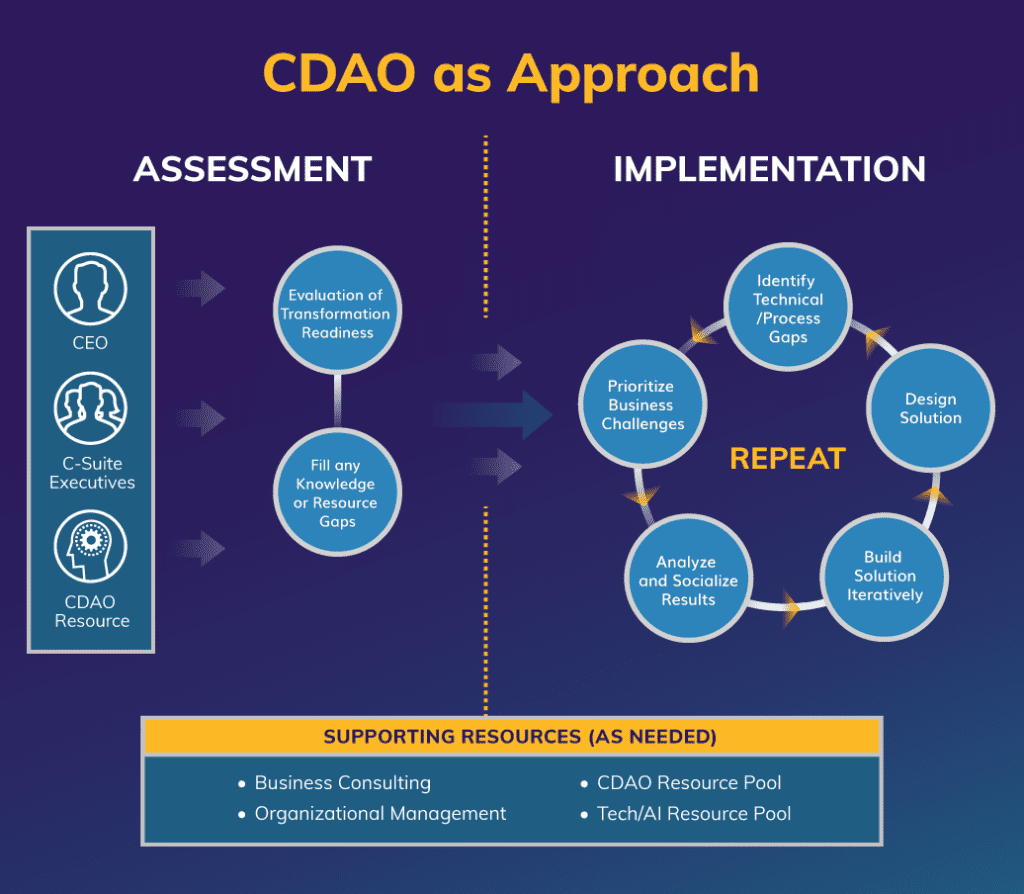What is a chief data and analytics officer (CDAO), and why do you need one to implement your business-driven data strategies? We explain six key insights for data-driven leadership in this blog post.
In brief:
- Data-driven leadership is essential for success. Clear strategic direction, executive sponsorship, and top-down change management are critical.
- However, hiring a CDAO to help deliver data-driven leadership does not guarantee success. CDAOs need strategic partnership from the CEO to align data initiatives with business goals. In many cases, a full-time CDAO isn’t needed.
- CDAO as a service (CDAOaaS) offers flexibility and expertise. This model pairs CEOs with a seasoned CDAO backed by a consulting team to offer tailored, scalable data solutions without the long-term overhead.
Companies that foster a strong data culture and take a data-driven approach significantly outperform those that don’t.
CEOs are eager to harness their data as a strategic asset. However, the path to becoming truly data-driven is full of pitfalls and misconceptions. For example, simply hiring a chief data and analytics officer (CDAO) or investing in the latest technology won’t automatically transform your organization into a data powerhouse.
The reality is: Successful data transformation requires thoughtful leadership, strategic alignment, and deep understanding of how data drives results. Many well-intentioned data initiatives fail because leaders lack clarity on the essential elements needed for success.
The following insights reveal what aspiring data-driven CEOs need to know about building effective data capabilities to accelerate your journey toward data-driven decision-making.
1. Data-Driven Leadership Starts at the Top
To become a data-driven company, you need a well-defined business strategy. That’s because it drives the data strategy, and only the CEO can define and communicate an organization’s short-term, medium-term, and long-term business goals. All levels of the business must then understand their roles in achieving those goals. These are the foundational blocks of any holistic, data-driven solution.
However, some CEOs allow information technology (IT) departments to take an “If you build it, they will come” approach to creating or updating data solutions. They may focus on a specific delivery pattern or set of tools that produce standardized analytics and assume they will solve all users’ problems.
The reality is more like “If you build it without gathering users’ specific needs, they probably will not come.” Instead, the results are usually:
- Business users grow shadow IT by taking data from the system, putting it into Excel, and manipulating it for their needs. This wastes time, creates a significant risk of manual error or security breaches, and creates the possibility of misinterpreted data.
- Analytical reports, dashboards, and the like are built, refreshed, and maintained — but not used. Another waste of time and money.
- Reports and tools aren’t used to inform business actions. This result is the worst of the three, because it generates resources that don’t move the company closer to its short-term goals and long-term vision.
Because of these likely outcomes, becoming data-driven often requires organizational change. Smart CEOs will engage change management experts to oversee the planning, effort, time, and clear communication about how changes will benefit employees.
When employees understand that the mandate for change is coming from — and supported by — the highest reaches of the organization, they’ll more readily accept the new processes or technologies that leaders have required them to adopt.
2. Hiring a CDAO Is Not Enough for Data-Driven Leadership
Some CEOs have hired or promoted a CDAO, expecting them to turn data into gold. Of course, they can’t — and that misunderstanding is why the average tenure of a CDAO is about two years. In these instances, either the company or the person in that role failed to realize the full scope of what they needed to do and the potential impact that work could have on the day-to-day functioning of the business.
A CEO must partner with the CDAO so that the data officer has a clear picture of where the business needs to go and devise a strategy for using data to get there. As the CEO learns and shares the overall business strategy with the CDAO, the CDAO lays a foundation for understanding technology, processes, and governance available to help downstream stakeholders achieve their goals while supporting the overall direction of the business.
However, most industries will not need a full-time CDAO once a data solution is defined and implemented. That solution should be able to run without oversight, unless your business directly monetizes data or constantly faces changing needs or compliance risks. Typically, you should only need to revisit your data solution every three to six years to ensure alignment with business and technology changes.
3. Buying New Technology Is Not Enough for Data-Driven Leadership
Vendors with strong marketing departments want you to believe that a specific tool or suite of tools will answer all your data problems. This claim is becoming more frequent as artificial intelligence (AI) is ingrained into more and more offerings.
The truth: All insight requires high-quality, well-defined data.
The old maxim “garbage in, garbage out” applies as much in the age of AI as ever. To have high-quality data, you need people and processes that consistently produce well-defined and well-understood data. Only then can decision-makers apply that data to well-defined business needs and drive actions that breed success.
4. CDAOs Don’t Need to Know Your Business — And It May Be Better If They Don’t
It’s often not important for the CDAO to know your business.
According to a NewVantage Partners survey, 51 percent of executives in Fortune 100 firms think a successful CDAO should be an external hire with fresh perspectives. In other words, you don’t need to promote CDAOs from within, and you may not even need to hire them from your industry for them to succeed.
Instead, the critical skill set for a CDAO is a clear understanding of all aspects of data governance and how to apply them to your situation, combined with understanding the breadth of available solution designs and tech capabilities. The role of the CEO and other C-level executives is to understand the business’s needs and define them for the CDAO. That way, the CDAO can apply their knowledge and skill set to informing and helping them achieve the ultimate business vision.
5. Data Governance Is Not Optional
While the term “data governance” is well recognized, its scope and breadth are not well understood — and its importance is increasing daily, thanks to AI and other advanced analytics methodologies, such as cluster analytics and predictive analytics.
That means one of the CDAO’s primary jobs is to implement all aspects of data governance at the appropriate level for your business. Data must be clean, well-defined, and fully populated to be useful. Procuring that data can only be achieved with a clear understanding of the components below, and when and how to apply them:
- Data Policies and Standards
- Data Stewardship
- Data Quality Management
- Data Privacy and Security
- Data Architecture and Metadata Management
- Data Compliance and Risk Management
- Data Access and Usage Policies
- Data Life Cycle Management
- Data Governance Framework
- Data Culture and Awareness
- Data Governance Metrics and KPIs
- AI Ethicist
- AI Risk and Governance Specialist
That’s a long list. It bears repeating that with the rise of generative AI and other advanced analytics methodologies, the need for clean, well-defined, fully populated data is only going to grow. CDAO as a service can help.
6. Consider CDAO as a Service
CDAO as a service (CDAOaaS) increases the likelihood of successful data transformations or strategy development because it addresses many of the reasons these efforts fail.
Start with hiring a specially trained consultant as your CDAO who’s backed by an interdisciplinary team of high-quality subject matter experts. An individual, or team of individuals, backed by the full force of a consulting company will help turn your data into insights, profitability, and assets that achieve your vision.
You’ll then be able to access the most current guidance, knowledge, and experience while supplementing your staff with the right resources to execute your data road map.
The diagram below depicts the transformation process with this CDAOaaS approach. It’s divided into two parts:
- In the assessment phase, the CDAO assesses your needs and evaluates your readiness to address those needs. A battle-tested and trained CDAO resource will be able to identify any significant gaps in your ability to achieve your desired end state before you encounter them.
- Then, in the implementation phase, the CDAO can help you make an informed decision about whether the cost and effort make sense for your business, providing the opportunity to right-size before you begin.
Accelerate Your Journey Toward Strong Data-Driven Leadership
Developing data-driven leadership is not a simple undertaking. It looks different for every company, and there is no one-size-fits-all solution.
The best and simplest way forward for most businesses is for the CEO to leverage CDAO as a service. Partner with a CDAO backed by a consulting firm that will adapt to and address your business’s specific needs and guide you through the conception, planning, and implementation of a successful data solution.
Are you ready to move forward with a data strategy for your organization but aren’t sure where to start? Our Data and Analytics experts bring a tried-and-true approach for executing strategies into practical, pragmatic and actionable plans. Talk to an expert






